Accountable Care Organizations: Roles, Challenges, and Benefits
VerifiedAdded on 2023/03/20
|7
|1536
|20
Essay
AI Summary
This essay provides a comprehensive overview of Accountable Care Organizations (ACOs), which aim to deliver high-quality, coordinated, and patient-centered care through collaboration among healthcare providers. It explores the impact of ACOs on both care providers and recipients, highlighting improved relationships, increased opportunities, and better care coordination for providers, as well as enhanced accessibility, communication, and cost-effective care for patients. The essay delves into the importance of clarifying professional roles, developing performance metrics, and holding professionals accountable to ensure accountability within ACOs. It also addresses the challenges faced by ACOs, such as staff shortages, technological incompatibilities, and poor management, and how these challenges lead to changing roles for healthcare workers. In conclusion, the essay emphasizes the significance of ACOs in modern healthcare and the need for adaptability and effective strategies to overcome the obstacles they face.
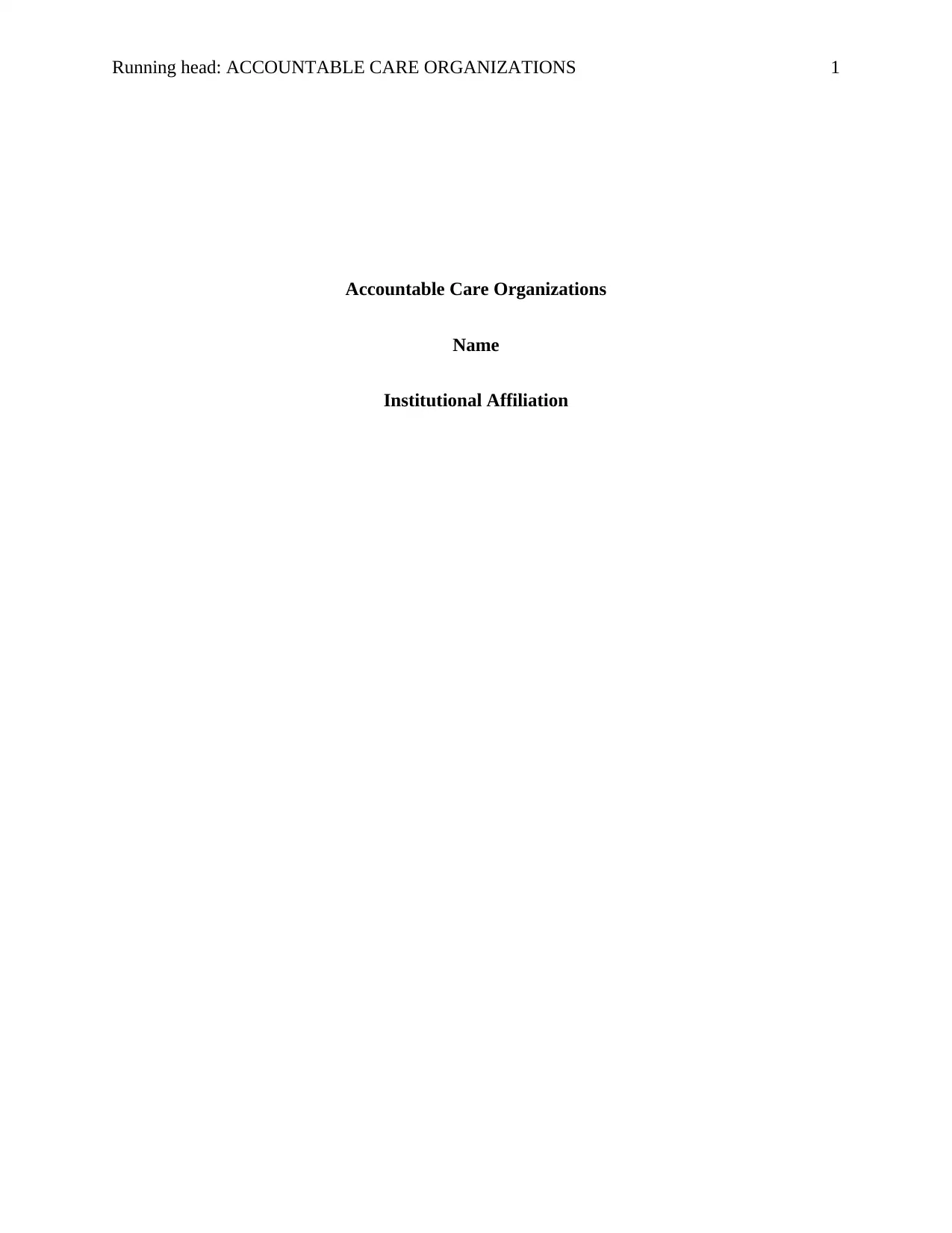
Running head: ACCOUNTABLE CARE ORGANIZATIONS 1
Accountable Care Organizations
Name
Institutional Affiliation
Accountable Care Organizations
Name
Institutional Affiliation
Paraphrase This Document
Need a fresh take? Get an instant paraphrase of this document with our AI Paraphraser
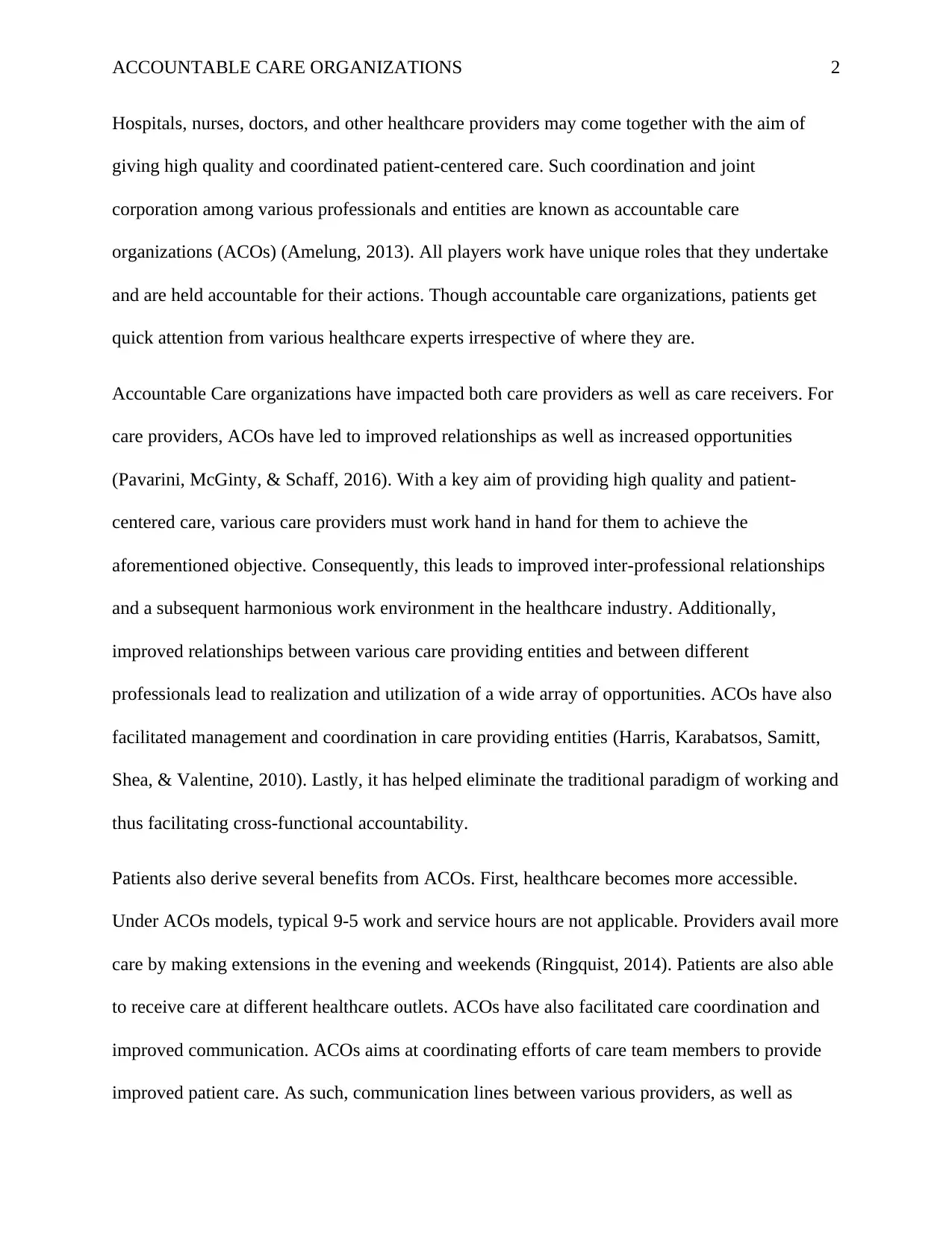
ACCOUNTABLE CARE ORGANIZATIONS 2
Hospitals, nurses, doctors, and other healthcare providers may come together with the aim of
giving high quality and coordinated patient-centered care. Such coordination and joint
corporation among various professionals and entities are known as accountable care
organizations (ACOs) (Amelung, 2013). All players work have unique roles that they undertake
and are held accountable for their actions. Though accountable care organizations, patients get
quick attention from various healthcare experts irrespective of where they are.
Accountable Care organizations have impacted both care providers as well as care receivers. For
care providers, ACOs have led to improved relationships as well as increased opportunities
(Pavarini, McGinty, & Schaff, 2016). With a key aim of providing high quality and patient-
centered care, various care providers must work hand in hand for them to achieve the
aforementioned objective. Consequently, this leads to improved inter-professional relationships
and a subsequent harmonious work environment in the healthcare industry. Additionally,
improved relationships between various care providing entities and between different
professionals lead to realization and utilization of a wide array of opportunities. ACOs have also
facilitated management and coordination in care providing entities (Harris, Karabatsos, Samitt,
Shea, & Valentine, 2010). Lastly, it has helped eliminate the traditional paradigm of working and
thus facilitating cross-functional accountability.
Patients also derive several benefits from ACOs. First, healthcare becomes more accessible.
Under ACOs models, typical 9-5 work and service hours are not applicable. Providers avail more
care by making extensions in the evening and weekends (Ringquist, 2014). Patients are also able
to receive care at different healthcare outlets. ACOs have also facilitated care coordination and
improved communication. ACOs aims at coordinating efforts of care team members to provide
improved patient care. As such, communication lines between various providers, as well as
Hospitals, nurses, doctors, and other healthcare providers may come together with the aim of
giving high quality and coordinated patient-centered care. Such coordination and joint
corporation among various professionals and entities are known as accountable care
organizations (ACOs) (Amelung, 2013). All players work have unique roles that they undertake
and are held accountable for their actions. Though accountable care organizations, patients get
quick attention from various healthcare experts irrespective of where they are.
Accountable Care organizations have impacted both care providers as well as care receivers. For
care providers, ACOs have led to improved relationships as well as increased opportunities
(Pavarini, McGinty, & Schaff, 2016). With a key aim of providing high quality and patient-
centered care, various care providers must work hand in hand for them to achieve the
aforementioned objective. Consequently, this leads to improved inter-professional relationships
and a subsequent harmonious work environment in the healthcare industry. Additionally,
improved relationships between various care providing entities and between different
professionals lead to realization and utilization of a wide array of opportunities. ACOs have also
facilitated management and coordination in care providing entities (Harris, Karabatsos, Samitt,
Shea, & Valentine, 2010). Lastly, it has helped eliminate the traditional paradigm of working and
thus facilitating cross-functional accountability.
Patients also derive several benefits from ACOs. First, healthcare becomes more accessible.
Under ACOs models, typical 9-5 work and service hours are not applicable. Providers avail more
care by making extensions in the evening and weekends (Ringquist, 2014). Patients are also able
to receive care at different healthcare outlets. ACOs have also facilitated care coordination and
improved communication. ACOs aims at coordinating efforts of care team members to provide
improved patient care. As such, communication lines between various providers, as well as
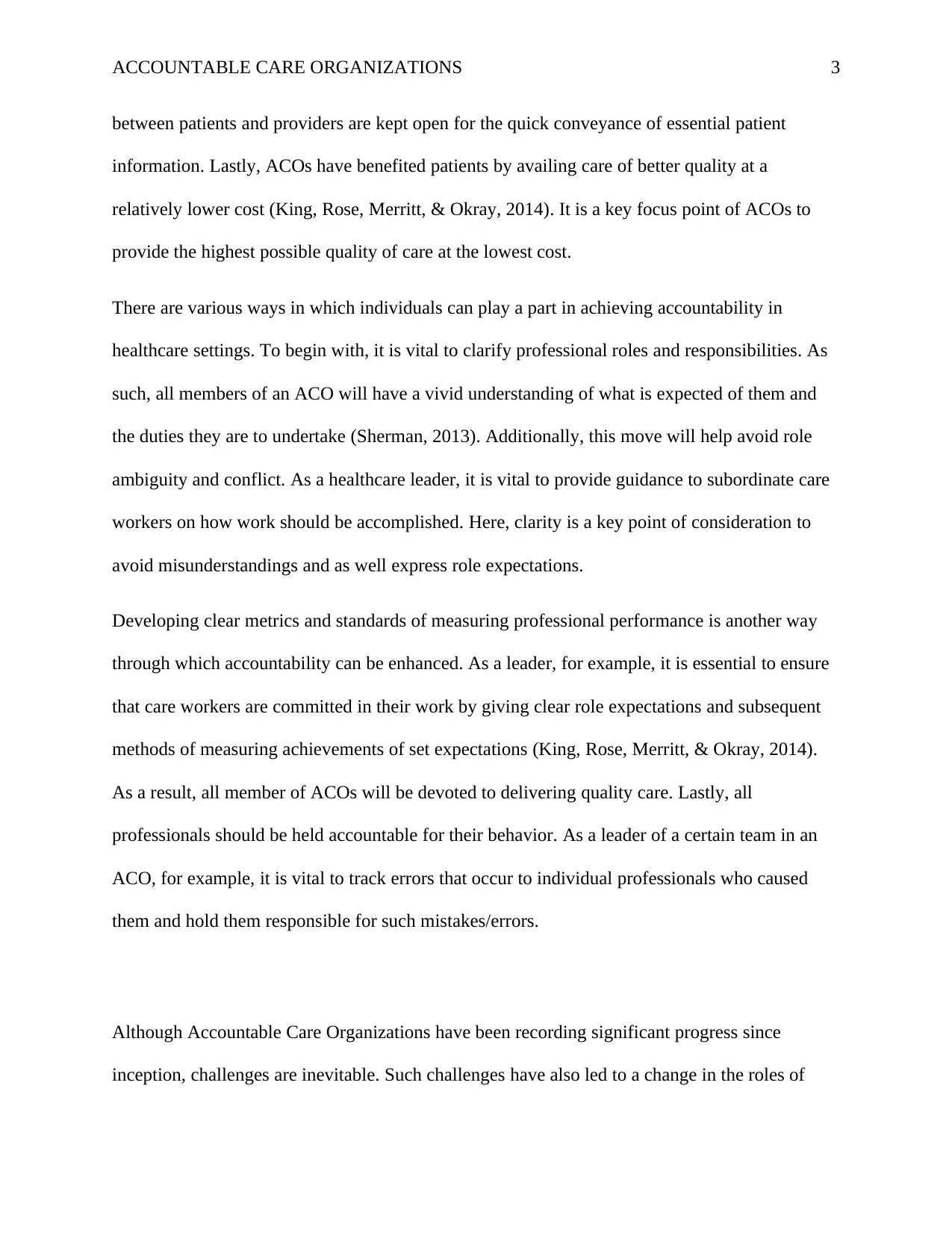
ACCOUNTABLE CARE ORGANIZATIONS 3
between patients and providers are kept open for the quick conveyance of essential patient
information. Lastly, ACOs have benefited patients by availing care of better quality at a
relatively lower cost (King, Rose, Merritt, & Okray, 2014). It is a key focus point of ACOs to
provide the highest possible quality of care at the lowest cost.
There are various ways in which individuals can play a part in achieving accountability in
healthcare settings. To begin with, it is vital to clarify professional roles and responsibilities. As
such, all members of an ACO will have a vivid understanding of what is expected of them and
the duties they are to undertake (Sherman, 2013). Additionally, this move will help avoid role
ambiguity and conflict. As a healthcare leader, it is vital to provide guidance to subordinate care
workers on how work should be accomplished. Here, clarity is a key point of consideration to
avoid misunderstandings and as well express role expectations.
Developing clear metrics and standards of measuring professional performance is another way
through which accountability can be enhanced. As a leader, for example, it is essential to ensure
that care workers are committed in their work by giving clear role expectations and subsequent
methods of measuring achievements of set expectations (King, Rose, Merritt, & Okray, 2014).
As a result, all member of ACOs will be devoted to delivering quality care. Lastly, all
professionals should be held accountable for their behavior. As a leader of a certain team in an
ACO, for example, it is vital to track errors that occur to individual professionals who caused
them and hold them responsible for such mistakes/errors.
Although Accountable Care Organizations have been recording significant progress since
inception, challenges are inevitable. Such challenges have also led to a change in the roles of
between patients and providers are kept open for the quick conveyance of essential patient
information. Lastly, ACOs have benefited patients by availing care of better quality at a
relatively lower cost (King, Rose, Merritt, & Okray, 2014). It is a key focus point of ACOs to
provide the highest possible quality of care at the lowest cost.
There are various ways in which individuals can play a part in achieving accountability in
healthcare settings. To begin with, it is vital to clarify professional roles and responsibilities. As
such, all members of an ACO will have a vivid understanding of what is expected of them and
the duties they are to undertake (Sherman, 2013). Additionally, this move will help avoid role
ambiguity and conflict. As a healthcare leader, it is vital to provide guidance to subordinate care
workers on how work should be accomplished. Here, clarity is a key point of consideration to
avoid misunderstandings and as well express role expectations.
Developing clear metrics and standards of measuring professional performance is another way
through which accountability can be enhanced. As a leader, for example, it is essential to ensure
that care workers are committed in their work by giving clear role expectations and subsequent
methods of measuring achievements of set expectations (King, Rose, Merritt, & Okray, 2014).
As a result, all member of ACOs will be devoted to delivering quality care. Lastly, all
professionals should be held accountable for their behavior. As a leader of a certain team in an
ACO, for example, it is vital to track errors that occur to individual professionals who caused
them and hold them responsible for such mistakes/errors.
Although Accountable Care Organizations have been recording significant progress since
inception, challenges are inevitable. Such challenges have also led to a change in the roles of
⊘ This is a preview!⊘
Do you want full access?
Subscribe today to unlock all pages.

Trusted by 1+ million students worldwide
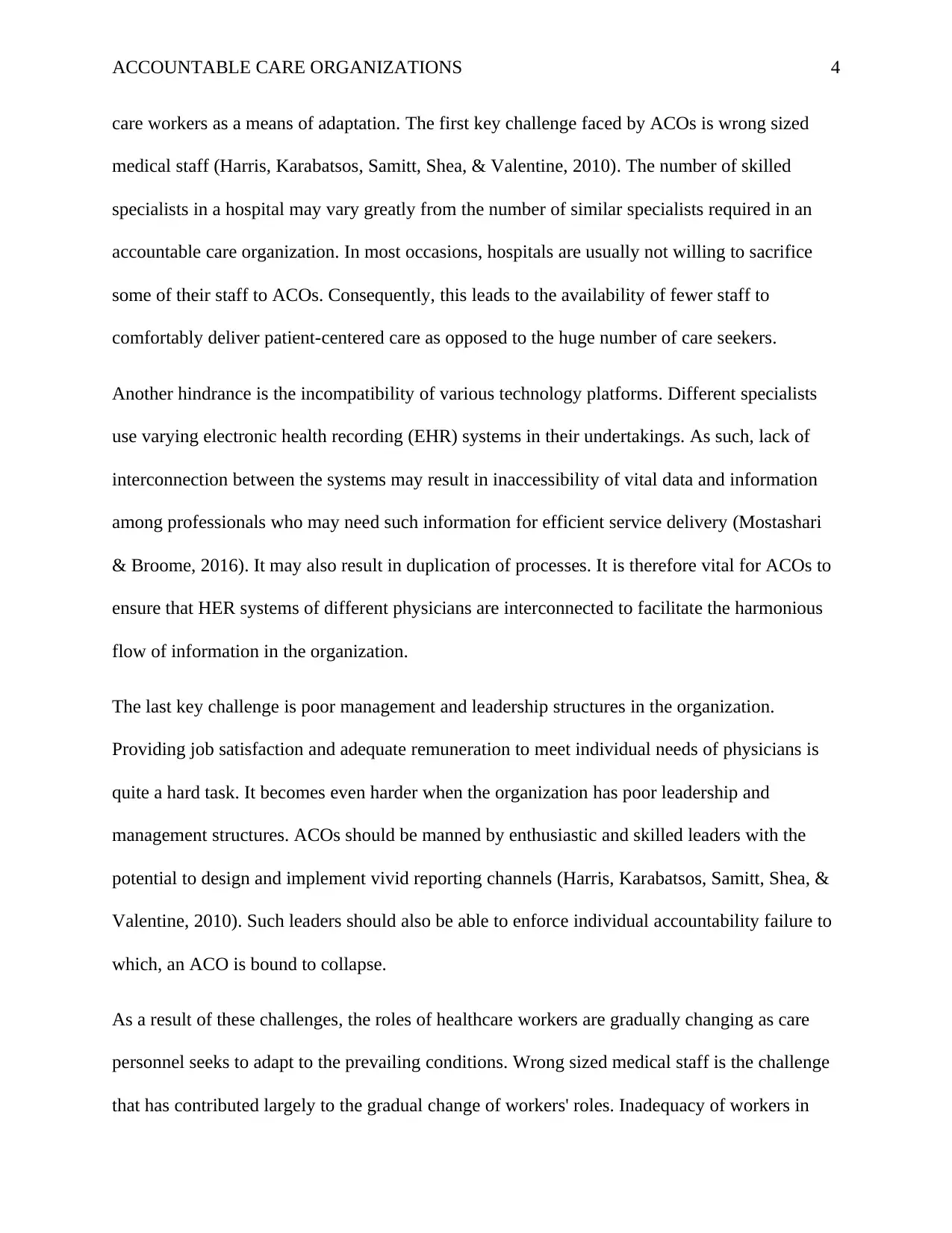
ACCOUNTABLE CARE ORGANIZATIONS 4
care workers as a means of adaptation. The first key challenge faced by ACOs is wrong sized
medical staff (Harris, Karabatsos, Samitt, Shea, & Valentine, 2010). The number of skilled
specialists in a hospital may vary greatly from the number of similar specialists required in an
accountable care organization. In most occasions, hospitals are usually not willing to sacrifice
some of their staff to ACOs. Consequently, this leads to the availability of fewer staff to
comfortably deliver patient-centered care as opposed to the huge number of care seekers.
Another hindrance is the incompatibility of various technology platforms. Different specialists
use varying electronic health recording (EHR) systems in their undertakings. As such, lack of
interconnection between the systems may result in inaccessibility of vital data and information
among professionals who may need such information for efficient service delivery (Mostashari
& Broome, 2016). It may also result in duplication of processes. It is therefore vital for ACOs to
ensure that HER systems of different physicians are interconnected to facilitate the harmonious
flow of information in the organization.
The last key challenge is poor management and leadership structures in the organization.
Providing job satisfaction and adequate remuneration to meet individual needs of physicians is
quite a hard task. It becomes even harder when the organization has poor leadership and
management structures. ACOs should be manned by enthusiastic and skilled leaders with the
potential to design and implement vivid reporting channels (Harris, Karabatsos, Samitt, Shea, &
Valentine, 2010). Such leaders should also be able to enforce individual accountability failure to
which, an ACO is bound to collapse.
As a result of these challenges, the roles of healthcare workers are gradually changing as care
personnel seeks to adapt to the prevailing conditions. Wrong sized medical staff is the challenge
that has contributed largely to the gradual change of workers' roles. Inadequacy of workers in
care workers as a means of adaptation. The first key challenge faced by ACOs is wrong sized
medical staff (Harris, Karabatsos, Samitt, Shea, & Valentine, 2010). The number of skilled
specialists in a hospital may vary greatly from the number of similar specialists required in an
accountable care organization. In most occasions, hospitals are usually not willing to sacrifice
some of their staff to ACOs. Consequently, this leads to the availability of fewer staff to
comfortably deliver patient-centered care as opposed to the huge number of care seekers.
Another hindrance is the incompatibility of various technology platforms. Different specialists
use varying electronic health recording (EHR) systems in their undertakings. As such, lack of
interconnection between the systems may result in inaccessibility of vital data and information
among professionals who may need such information for efficient service delivery (Mostashari
& Broome, 2016). It may also result in duplication of processes. It is therefore vital for ACOs to
ensure that HER systems of different physicians are interconnected to facilitate the harmonious
flow of information in the organization.
The last key challenge is poor management and leadership structures in the organization.
Providing job satisfaction and adequate remuneration to meet individual needs of physicians is
quite a hard task. It becomes even harder when the organization has poor leadership and
management structures. ACOs should be manned by enthusiastic and skilled leaders with the
potential to design and implement vivid reporting channels (Harris, Karabatsos, Samitt, Shea, &
Valentine, 2010). Such leaders should also be able to enforce individual accountability failure to
which, an ACO is bound to collapse.
As a result of these challenges, the roles of healthcare workers are gradually changing as care
personnel seeks to adapt to the prevailing conditions. Wrong sized medical staff is the challenge
that has contributed largely to the gradual change of workers' roles. Inadequacy of workers in
Paraphrase This Document
Need a fresh take? Get an instant paraphrase of this document with our AI Paraphraser
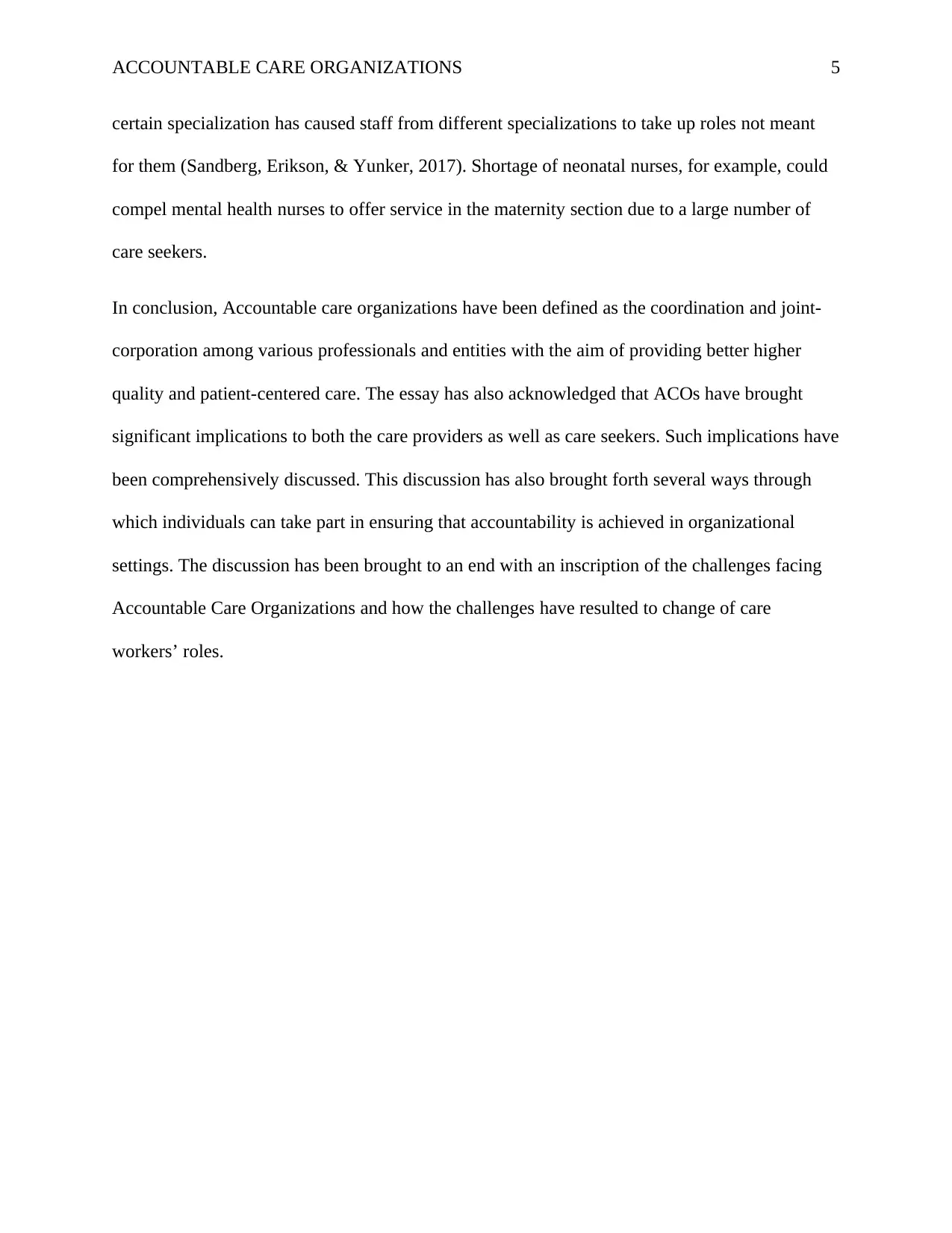
ACCOUNTABLE CARE ORGANIZATIONS 5
certain specialization has caused staff from different specializations to take up roles not meant
for them (Sandberg, Erikson, & Yunker, 2017). Shortage of neonatal nurses, for example, could
compel mental health nurses to offer service in the maternity section due to a large number of
care seekers.
In conclusion, Accountable care organizations have been defined as the coordination and joint-
corporation among various professionals and entities with the aim of providing better higher
quality and patient-centered care. The essay has also acknowledged that ACOs have brought
significant implications to both the care providers as well as care seekers. Such implications have
been comprehensively discussed. This discussion has also brought forth several ways through
which individuals can take part in ensuring that accountability is achieved in organizational
settings. The discussion has been brought to an end with an inscription of the challenges facing
Accountable Care Organizations and how the challenges have resulted to change of care
workers’ roles.
certain specialization has caused staff from different specializations to take up roles not meant
for them (Sandberg, Erikson, & Yunker, 2017). Shortage of neonatal nurses, for example, could
compel mental health nurses to offer service in the maternity section due to a large number of
care seekers.
In conclusion, Accountable care organizations have been defined as the coordination and joint-
corporation among various professionals and entities with the aim of providing better higher
quality and patient-centered care. The essay has also acknowledged that ACOs have brought
significant implications to both the care providers as well as care seekers. Such implications have
been comprehensively discussed. This discussion has also brought forth several ways through
which individuals can take part in ensuring that accountability is achieved in organizational
settings. The discussion has been brought to an end with an inscription of the challenges facing
Accountable Care Organizations and how the challenges have resulted to change of care
workers’ roles.
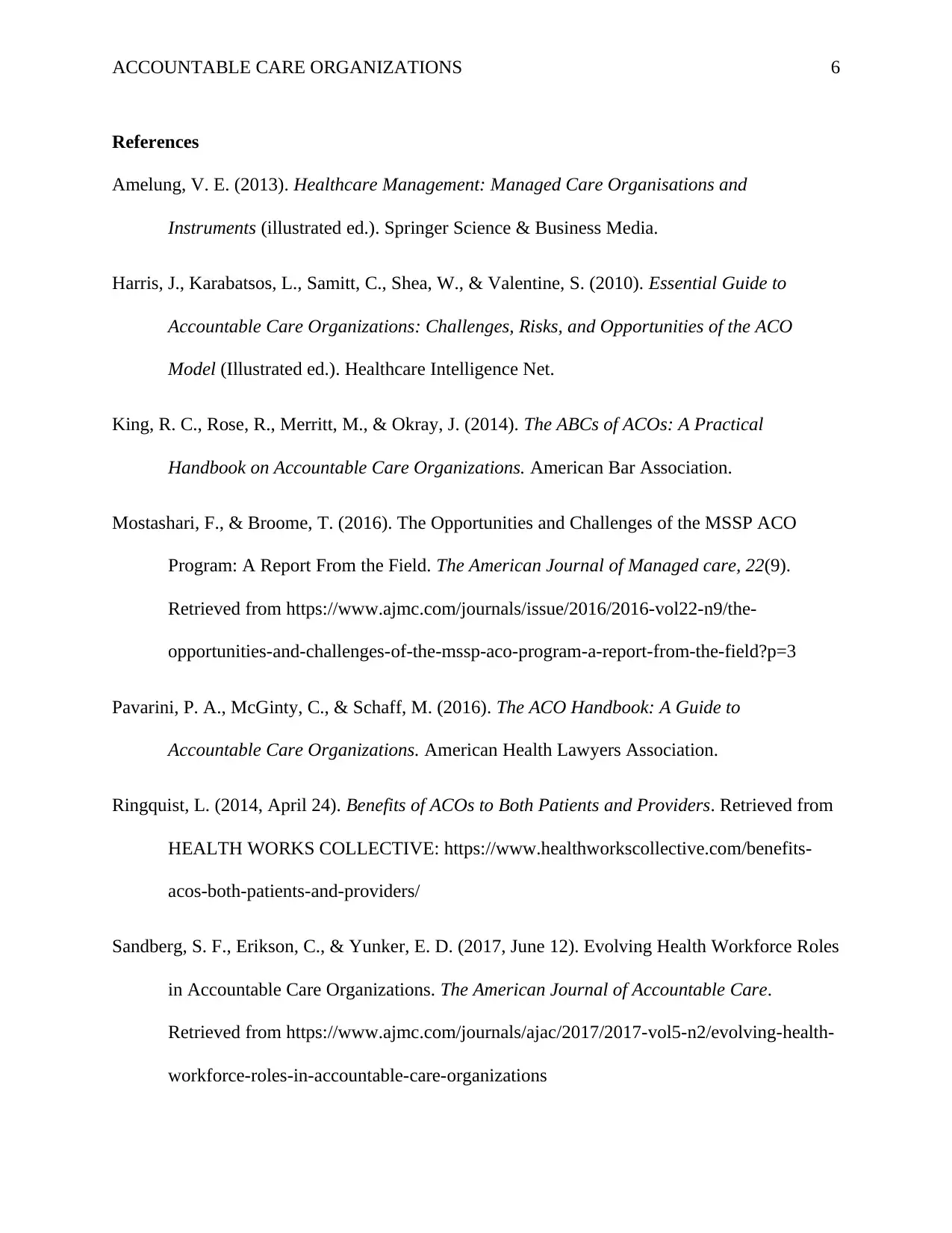
ACCOUNTABLE CARE ORGANIZATIONS 6
References
Amelung, V. E. (2013). Healthcare Management: Managed Care Organisations and
Instruments (illustrated ed.). Springer Science & Business Media.
Harris, J., Karabatsos, L., Samitt, C., Shea, W., & Valentine, S. (2010). Essential Guide to
Accountable Care Organizations: Challenges, Risks, and Opportunities of the ACO
Model (Illustrated ed.). Healthcare Intelligence Net.
King, R. C., Rose, R., Merritt, M., & Okray, J. (2014). The ABCs of ACOs: A Practical
Handbook on Accountable Care Organizations. American Bar Association.
Mostashari, F., & Broome, T. (2016). The Opportunities and Challenges of the MSSP ACO
Program: A Report From the Field. The American Journal of Managed care, 22(9).
Retrieved from https://www.ajmc.com/journals/issue/2016/2016-vol22-n9/the-
opportunities-and-challenges-of-the-mssp-aco-program-a-report-from-the-field?p=3
Pavarini, P. A., McGinty, C., & Schaff, M. (2016). The ACO Handbook: A Guide to
Accountable Care Organizations. American Health Lawyers Association.
Ringquist, L. (2014, April 24). Benefits of ACOs to Both Patients and Providers. Retrieved from
HEALTH WORKS COLLECTIVE: https://www.healthworkscollective.com/benefits-
acos-both-patients-and-providers/
Sandberg, S. F., Erikson, C., & Yunker, E. D. (2017, June 12). Evolving Health Workforce Roles
in Accountable Care Organizations. The American Journal of Accountable Care.
Retrieved from https://www.ajmc.com/journals/ajac/2017/2017-vol5-n2/evolving-health-
workforce-roles-in-accountable-care-organizations
References
Amelung, V. E. (2013). Healthcare Management: Managed Care Organisations and
Instruments (illustrated ed.). Springer Science & Business Media.
Harris, J., Karabatsos, L., Samitt, C., Shea, W., & Valentine, S. (2010). Essential Guide to
Accountable Care Organizations: Challenges, Risks, and Opportunities of the ACO
Model (Illustrated ed.). Healthcare Intelligence Net.
King, R. C., Rose, R., Merritt, M., & Okray, J. (2014). The ABCs of ACOs: A Practical
Handbook on Accountable Care Organizations. American Bar Association.
Mostashari, F., & Broome, T. (2016). The Opportunities and Challenges of the MSSP ACO
Program: A Report From the Field. The American Journal of Managed care, 22(9).
Retrieved from https://www.ajmc.com/journals/issue/2016/2016-vol22-n9/the-
opportunities-and-challenges-of-the-mssp-aco-program-a-report-from-the-field?p=3
Pavarini, P. A., McGinty, C., & Schaff, M. (2016). The ACO Handbook: A Guide to
Accountable Care Organizations. American Health Lawyers Association.
Ringquist, L. (2014, April 24). Benefits of ACOs to Both Patients and Providers. Retrieved from
HEALTH WORKS COLLECTIVE: https://www.healthworkscollective.com/benefits-
acos-both-patients-and-providers/
Sandberg, S. F., Erikson, C., & Yunker, E. D. (2017, June 12). Evolving Health Workforce Roles
in Accountable Care Organizations. The American Journal of Accountable Care.
Retrieved from https://www.ajmc.com/journals/ajac/2017/2017-vol5-n2/evolving-health-
workforce-roles-in-accountable-care-organizations
⊘ This is a preview!⊘
Do you want full access?
Subscribe today to unlock all pages.

Trusted by 1+ million students worldwide
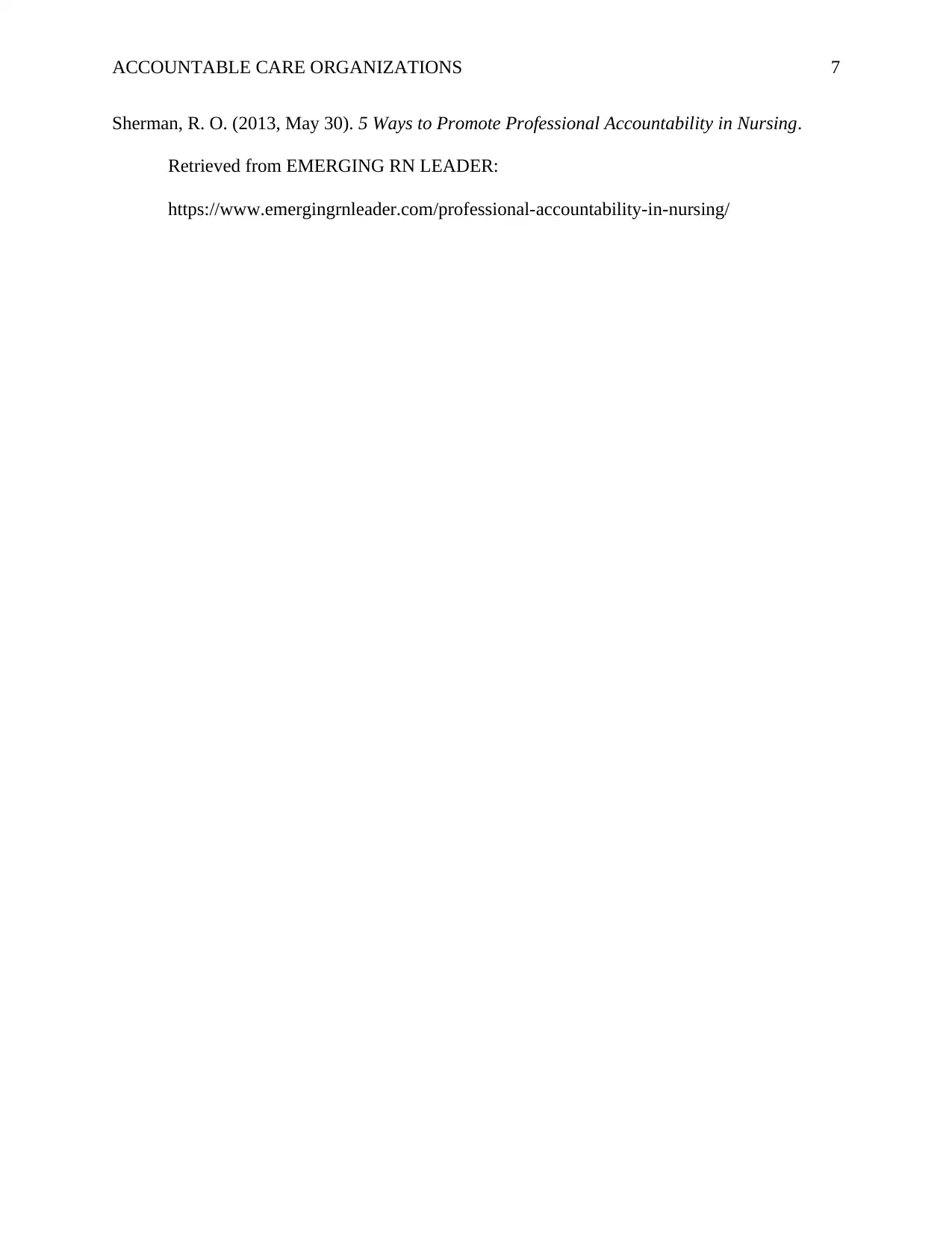
ACCOUNTABLE CARE ORGANIZATIONS 7
Sherman, R. O. (2013, May 30). 5 Ways to Promote Professional Accountability in Nursing.
Retrieved from EMERGING RN LEADER:
https://www.emergingrnleader.com/professional-accountability-in-nursing/
Sherman, R. O. (2013, May 30). 5 Ways to Promote Professional Accountability in Nursing.
Retrieved from EMERGING RN LEADER:
https://www.emergingrnleader.com/professional-accountability-in-nursing/
1 out of 7
Related Documents
Your All-in-One AI-Powered Toolkit for Academic Success.
+13062052269
info@desklib.com
Available 24*7 on WhatsApp / Email
![[object Object]](/_next/static/media/star-bottom.7253800d.svg)
Unlock your academic potential
Copyright © 2020–2025 A2Z Services. All Rights Reserved. Developed and managed by ZUCOL.




